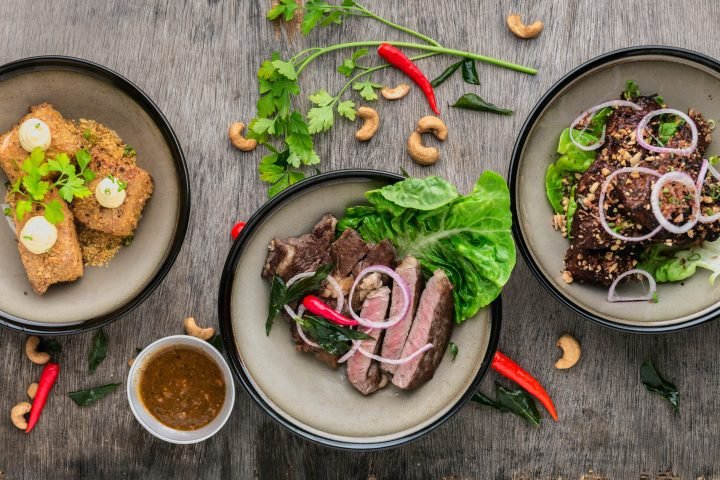In recent years, food culture has become increasingly diverse and experimental. One of the key drivers of this shift is fusion cuisine, which blends elements from different culinary traditions to create innovative dishes that challenge the boundaries of traditional cooking. Fusion cuisine is not just about mixing ingredients; it’s about merging techniques, flavors, and cultural influences to create something entirely new. As global connectivity grows and food accessibility increases, fusion cuisine is becoming a major force in shaping the future of food culture.
The Rise of Fusion Cuisine
Fusion cuisine’s roots can be traced back to the early 20th century, but it gained real popularity in the 1980s, particularly in cities like Los Angeles and New York, where food culture was already evolving rapidly. Early pioneers like Wolfgang Puck and Roy Yamaguchi are credited with popularizing fusion by combining elements of French, Italian, and Asian cooking. This innovative approach to cooking was not limited to fine dining but soon spread to street food, casual dining, and home kitchens.
Today, fusion cuisine continues to thrive, and its appeal is broadening as more chefs, home cooks, and food enthusiasts embrace the creative possibilities it offers. With access to global ingredients and culinary techniques, fusion dishes are no longer limited to a few select combinations. From sushi burritos to Korean BBQ tacos, fusion cuisine is transforming the way people view and experience food.
Why Fusion Cuisine Is So Popular
1. Globalization and Cultural Exchange With the world becoming more interconnected through travel, media, and immigration, people are exposed to a wider range of cuisines and flavors than ever before. This cultural exchange has created a fertile ground for the cross-pollination of culinary traditions. As people experiment with different spices, cooking methods, and ingredients from around the world, fusion cuisine naturally emerges as a way to combine these influences in exciting and unexpected ways.
2. Innovation and Creativity One of the biggest draws of fusion cuisine is the opportunity for chefs and home cooks to innovate and push the boundaries of traditional cooking. By breaking away from conventional recipes and thinking outside the box, fusion cuisine encourages creativity in the kitchen. This experimentation has led to the creation of groundbreaking dishes like ramen burgers, sushi tacos, and banh mi pizza—food that may not have existed just a few years ago but now define contemporary food trends.
3. Emphasis on Personalization Fusion cuisine allows people to tailor their dishes to their tastes and preferences. The blending of ingredients from different cultures enables individuals to choose flavors that suit their palates. This element of personalization is especially evident in the popularity of food trucks, pop-up restaurants, and fast-casual dining, where the menu can be as diverse as the people who create it. Whether it’s combining the spices of India with the comfort of American comfort food or adding Asian flavors to Latin American dishes, fusion cuisine offers endless customization opportunities.
4. Accessibility of Ingredients The global food market has made it easier than ever to access ingredients from all over the world. Asian supermarkets, farmer’s markets, and online grocery stores now carry a variety of spices, sauces, and produce that once might have been hard to find. This accessibility gives home cooks and professional chefs alike the chance to incorporate international flavors into their creations. This democratization of ingredients has made fusion cuisine more mainstream and allowed people to experience new flavor profiles at home or in local eateries.
How Fusion Cuisine is Impacting the Future of Food Culture
1. Creating New Culinary Identities Fusion cuisine is reshaping the way we think about culinary identity. Instead of adhering strictly to regional or cultural boundaries, fusion food allows for the blending of different heritages, creating a new kind of food identity that’s reflective of a globalized world. In cities like Los Angeles, Toronto, and London, where diverse populations bring a blend of flavors, fusion dishes are a reflection of cultural convergence and the increasingly fluid nature of food culture. This has also opened doors for chefs to explore and innovate in ways that honor their multicultural roots while embracing the melting pot of global influences.
2. Challenging Culinary Traditions Fusion cuisine has been both celebrated and criticized for challenging traditional culinary boundaries. Purists argue that blending culinary styles may result in the loss of authenticity, but proponents argue that it’s precisely this kind of innovation that drives food forward. The boundary-pushing nature of fusion cuisine encourages chefs to experiment with unfamiliar ingredients and techniques, often leading to the discovery of new textures, flavors, and cooking methods. This ongoing dialogue between tradition and innovation will likely continue to shape the way we approach food for years to come.
3. Sustainability and Global Flavors As sustainability becomes an increasingly important topic in food culture, fusion cuisine may also offer solutions to environmental challenges. By combining ingredients from diverse cuisines, chefs can reduce food waste by repurposing leftovers or using unusual parts of ingredients. Moreover, fusion cuisine can highlight locally grown produce and sustainable protein sources, blending them with international flavors. This creative approach to cooking not only fosters a more sustainable food system but also introduces consumers to the importance of food sustainability in a globalized world.
4. Social Media Influence The rise of social media platforms like Instagram and TikTok has given food creators a platform to showcase their unique fusion creations. Vibrant, visually appealing fusion dishes are more likely to go viral, creating a direct link between food and digital culture. Food photography and online sharing have amplified the trend, allowing fusion cuisine to spread quickly and influence food trends worldwide. The visual and experiential nature of fusion cuisine makes it ideal for sharing, thus fueling its popularity even more.
Fusion Cuisine Examples That Are Reshaping the Food Scene
1. Sushi Burritos Combining sushi and burritos, sushi burritos are a perfect example of how two beloved global foods can come together to create something exciting and innovative. Using sushi-grade fish, rice, and vegetables wrapped in seaweed, these oversized sushi rolls are a favorite in food trucks and fast-casual restaurants.
2. Korean BBQ Tacos Another great example of fusion cuisine, Korean BBQ tacos combine the tender, flavorful meats of Korean barbecue with the handheld convenience of Mexican tacos. Often filled with marinated bulgogi beef, kimchi, and a drizzle of spicy sauce, this dish is popular in food trucks across the U.S.
3. Indian Pizza Indian-inspired pizzas bring the rich spices and flavors of Indian cuisine to the familiar form of a pizza. Whether it’s using naan as the base or topping the pizza with tikka masala chicken, curry, and raita, this fusion dish combines the best of two worlds.
4. Ramen Burger Ramen burgers are a creative take on the classic hamburger. Instead of using a traditional bun, the sandwich is held together by crispy ramen noodle patties. This unique dish combines the savory flavors of ramen with the satisfaction of a burger, offering a perfect balance of textures and tastes.
Conclusion
Fusion cuisine is more than just a passing trend—it’s a reflection of our increasingly interconnected world and our desire to explore new flavors, textures, and culinary experiences. By blending ingredients and techniques from diverse cultures, fusion cuisine is breaking down traditional food boundaries and creating new ways of eating and experiencing food. As it continues to evolve, fusion cuisine will likely remain a key driver in the future of food culture, encouraging creativity, innovation, and cross-cultural collaboration. Whether you’re sampling a ramen burger or indulging in a sushi burrito, fusion cuisine invites us to embrace the delicious possibilities that arise when different culinary traditions come together.










